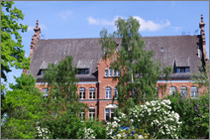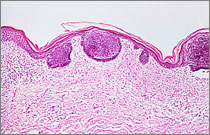All cancer sites
| 2020 | ||
|---|---|---|
¹ per 100,000 persons, age-standardised according to the old European standard population * calculated using the period method for 2019 / 2020 | ||
| Women | Men | |
| Incidence | 231,400 | 261,800 |
| Age-standardised incidence rate¹ | 337.4 | 406.7 |
| Deaths | 104,949 | 125,274 |
| Age-standardised mortality rate¹ | 118.7 | 174.9 |
| 5-year prevalence | 801,700 | 835,000 |
| 10-year prevalence | 1,384,600 | 1,379,200 |
| Relative 5-year survival rate* | 66 % | 62 % |
| Relative 10-year survival rate* | 61 % | 57 % |
‘All cancer sites’ is the term used here to describe all primary malignant neoplasms including lymphomas and leukaemias. Non-melanoma skin cancers are not included, as is internationally typical. These cancers contribute only very slightly to cancer mortality despite their high frequency of occurrence.
Different cell types as the origin of cancer
Malignant neoplasms can arise from different cell types in different organs of the body. Most cancers originate in the inner and outer surface tissues of the body (epithelium). Approximately 70 percent of all tumours are adenocarcinomas originating from glandular epithelial tissue. A further 15 percent are squamous cell carcinomas, malignant tumours of the transitional epithelium (urothelial carcinomas) and small cell carcinomas that occur, for example, in the lung. Leukaemias and lymphomas originate from haematopoietic bone marrow and lymphatic tissue. In addition, malignant tumours can also originate in connective and supporting tissue (including sarcomas), in supporting cells of the nervous system (gliomas) or pigment-forming cells (melanomas).
Approximately 493,200 new cancer cases in 2020
The ZfKD estimates that in 2020, a total of around 493,200 new cancer cases were diagnosed in Germany. Of these, approximately 261,800 cases occurred in men and 231,400 in women. About half of the cases were diagnosed in the breast (71,300), the prostate (65,800), the colon (54,800) or the lung (56,700).

![]() Age-standardised incidence and mortality rates by sex, ICD-10 C00-C97 without C44, Germany 1999 – 2017/2018, projection (incidence) through 2022, per 100,000 (old European standard population)
Age-standardised incidence and mortality rates by sex, ICD-10 C00-C97 without C44, Germany 1999 – 2017/2018, projection (incidence) through 2022, per 100,000 (old European standard population)
These differences are mainly due to the sex-specific trends in lung cancer and other cancers promoted by cigarette smoking, which have been decreasing for men and increasing for women. A high proportion of the overall decrease in cancer incidence rates is due to the favourable developments of stomach and colorectal cancers, with decreases of more than 20 percent over the last 10 years.
Around 1.6 million people in Germany live with a cancer that has been diagnosed within the last 5 years. For 4.5 million people had a cancer diagnosis in the last 25 years.
Survival prospects vary greatly depending on the type of cancer
Relative 5-year survival rates compare the survival of cancer patients with survival in the general population of the same age and sex. These rates are highly dependent on the type of tumour and range from below 10 percent for malignant tumours of the lung, liver and pancreas to above 90 percent for malignant melanoma of the skin, testicular cancer and prostate cancer.

![]() Relative 5-/10-year survival rates by tumour site and sex, Germany 2019 – 2020 (period analysis).
Relative 5-/10-year survival rates by tumour site and sex, Germany 2019 – 2020 (period analysis).
Smoking, overweight, nutrition: Some risk factors are avoidable
For many cancers, the mechanisms of carcinogenesis are not yet fully known or the known causes cannot be influenced. Prevention strategies are therefore only available for a few tumour types. However, these include cancers that affect a large number of people. The World Health Organization (WHO) suggests that 30 to 50 percent of all cancer cases worldwide could be avoided through known prevention measures. The German Cancer Research Center (DKFZ) estimates that at least 37 percent of all new cancer cases in Germany can be attributed to avoidable or at least modifiable risk factors.
Tobacco consumption is the most important avoidable cancer risk factor. About 19 percent of annual incident cancer cases in Germany are attributable to smoking (the attributable fraction). Associations of overweight and lack of exercise with higher cancer risk have also been shown in numerous observational epidemiological studies. Possible biological mechanisms behind these associations are made clearer through recent research on the metabolic syndrome. This chronic metabolic imbalance is associated with high blood pressure and high blood levels of fat and sugar. Subsequent inflammatory processes in fatty tissue are presumably involved in the development of cancer.
Among the individual nutrition-dependent factors, alcohol consumption plays an important role. Low dietary consumption of fruit, vegetables or fibre with an often concomitant high consumption of red and processed meat has been observed in conjunction with increased risk for several common tumour types. In observational studies, however, the influence of individual foods and their nutritional components cannot always be separated from the impact of energy balance and other possible confounding factors. Among the avoidable cancer risk factors is the ultraviolet portion of sunlight (UV radiation).
Environmental factors and certain diseases can have an influence
Many people in Germany overestimate the overall impact of harmful substances and impurities in food, as well as that of environmental factors or exposures in the workplace. In individual cases, however, these factors can also play a significant role in the development of cancer in Germany. Examples are the regionally naturally occurring noble gas radon, which is suggested to cause about 6 percent of all annual lung cancer cases in Germany, and former occupational asbestos exposure, which due to the long latency period still leads to mesotheliomas of the pleura or peritoneum today. Medical procedures can also increase the risk of cancer in individual cases; for example, diagnostic and therapeutic procedures involving radiation exposure, cytostatic drugs for chemotherapy or menopausal hormone therapy found to increase risk of breast cancer.
Chronic infections are now known to be risk factors for some common types of cancer: about 4 percent of all annual incident cancers in Germany can be attributed to infections. Vaccinations or therapies can help to reduce the risk of cancer. This has been proven, for example, for vaccination against hepatitis B viruses as a protective measure against liver cancer. A similar effect is expected from the HPV vaccination: It should reduce the incidence not only of cervical cancer, but also of tumours of the oropharynx, penis and anus as well as of the vulva and vagina. This is predicated on the condition that enough young people are vaccinated. Studies have already shown a significant reduction in precancerous lesions of the cervix for vaccinated patients.
In addition to avoidable causes, genetic factors can also increase the risk of cancer. So far, however, few genetic alterations have been clearly identified as the cause of certain types of tumours, such as breast, ovarian or colon cancers.
The statutory health insurance in Germany offers examinations for the early detection of cancer of the skin and intestine as well as breast and cervix for women and prostate for men.
Date: 02.05.2024






